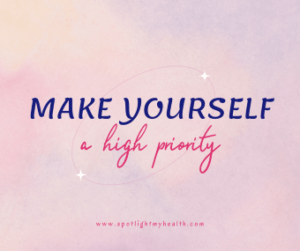The name of the game for 2022 is health. And by that, I mean complete health, as in mentally, physically and emotionally.
I’m claiming 2022 the year for self-care and all that entails. Becoming our best in all things healthy for each of us, individually and wholy.
Several months ago, I presented an article about Ayurveda, an ancient holistic way of healing that comes from the Vedic culture of India. Ayurveda is based on the notion that good health and our wellbeing depends on the balance between mind, body, and spirit.
In the U.S., Ayurveda is considered a complementary health approach. It focuses on restoring balance in the body through a personalized plan that can include massage, specialized diets, herbs, aromatherapy, and exercise.
Years ago, when I first heard of the Ayurveda way of health, it sounded very strange to me. But as I did more research and learned more about it, things actually began to make sense. I believe we need ways to combine Eastern and Western medicine and Ayurveda may be a good place to start.
What Is Ayurveda and Doshas?
Ayurveda, in Sanskrit, actually means, ‘The Science of Life’ or ‘The Sacred Knowledge of Life.’ This way of looking at our health puts the focus on prevention by doing what we need for our ‘body type or dosha.’ And at the same time, it encourages the maintenance of health using different therapies and/or holistic healing modalities. Ayurveda believes that each of us embodies a combination of all three doshas with one being more dominant that the other two.
This post is all about the basics of the three doshas or body types that each of us fit into. Just like with our chakras, Ayurveda also prescribes to the notion that the entire universe is comprised of energy in the form of five elements: Air, Fire, Water, Earth and Ether.
These elements combine in the body to form three energies or life forces, called doshas: vata, kapha, and pitta. Each dosha is a different combination of these five elements.
Unique Genes
Each of us has unique genes or DNA and Ayurveda also believes that our uniqueness also plays a part in our own combination of physical, emotional and mental characteristics. The more we know about own constitution or body type, the healthier we can keep ourselves.
To the Ayurveda way of looking at our health, disease is caused by an imbalance of the doshas or by something that has not been completely digested which refers to more than just our food. We can also have undigested feelings, thoughts and emotions that can and certainly do affect our health.
By restoring balance to our dominant dosha we will feel and be much better. Let’s look at each dosha separately.

In the U.S., Ayurvedic products are regulated as dietary supplements, therefore aren’t required to meet the same safety and effectiveness standards as drugs.
I would suggest that you choose to look for brands or products that have been certified by third-party testing such as ConsumerLabs, the U.S. Pharmacopeial Convention, or NSF International. These organizations provide a certain level of testing for quality, but can’t guarantee that a product is safe or effective.
Ayurveda Vata Dosha And Characteristics
Each of our doshas are not only connected to our mind and body but can also be associated with a time of day or season that suit our dosha best.
For vata that season is winter. Think of it this way, the qualities that we associate with fall and winter would also fit for a vata dosha. Cold, light, dry, clear, subtle, flowing, hard and rough. For a vata dosha, you might often feel frantic and ungrounded.
The vata dosha is a combination of space and air and is all about movement and I don’t mean exercise. It controls movement and is responsible for basic body processes such as the beating of our heart, breathing, cell division, circulation and muscle and tissue movement.
Vata body areas are the large intestine, pelvis, bones, skin, ears, and thighs. People with vata as their main dosha are believed to be quick-thinking, thin, and fast, and be susceptible to anxiety, dry skin, and constipation.
When vata is balanced it’s all about flexibility and creativity. If out of balance, vata can present as fearful and anxious. You can find that your skin becomes dry, your extremities are cold, you may have restless legs, a hoarse throat, stiff muscles, and joints.

To Keep Vata Dosha Balanced, Practice These Tips
**Massage yourself with oil daily. Actually, use a lot of oils, including healthy oils in your cooking.
**Practice modalities such as meditating or yoga. These encourage calmness internally and helps with stress.
**Spice your food generously with spices such as ginger, cinnamon, cardamon, fennel and turmeric.
**This dosha likes eating at regular times. And eat warm meals. Cold and raw foods, including salads with excessive salt will not help keep this dosha balanced.
**Routine and a regular sleep time do wonders for the vata dosha.
Ayurveda Pitta Dosha And Characteristics
The pitta dosha combines fire and water. It is thought to control hormones, the digestive system and our body’s metabolic system.
Pitta affects our nutrition and body temperature. Pitta’s body areas are the small intestines, stomach, sweat glands, skin, blood, and eyes.
People with pitta as their primary dosha are thought to have a fiery personality and can be assertive and determined. They may have an assessing and shrewd mind. They’ll have a muscular body.
When pitta is balanced, you’ll find it easy to make decisions and meet your goals. You’ll have a strong appetite and digestion.
Because pitta is associated with the fire element, balance is very important. Too much ‘pitta’ can cause anger and irritability and should tell you to “chillax” as my son used to say. You could also experience heartburn, high blood pressure and other inflammatory conditions.
You may feel anger, jealousy and self-criticism which isn’t good for anyone!
Physical symptoms can result in agitation, heartburn, nausea and diarrhea along with excess sweating, acne, oily skin, inflammation and burnout. This dosha can be susceptible to heart disease, stomach ulcers, inflammation, and arthritis.
An Out of Balance Pitta Dosha
If out of balance, the pitta dosha could experience irritability, mood swings, jealousy, be extremely judgmental and have a huge craving for spicy foods.
When any of these ailments are being felt, you should know your body is trying to tell you it is time to slow down. You also need to stop the competition to get more and more things done, even with yourself.
It’s time to create some inner quiet by going for a walk in nature or meditating. Something that quiets you down, something cool and soothing

To Keep Your Pitta Dosha Balanced, Try These Tips
**Slow down: summer is hot, so is not the time to start several new projects. Instead, this dosha would prefer you take it easy during the warmer months of the year.
**Avoid: anything intense and could cause a conflict from 10-2 especially in July and August. This is when heat is the worst and can help tempers flare and trigger arguments more than usual during these times.
**Exercise: Do any type of exercise early in the day when it is cooler, especially in the summer months. You want to avoid overheating a pitta constitution or you could bring about heat related illnesses.
**Moon: Sit outside in the evenings and enjoy the calmness the moon brings to this dosha.
**Essential Oils to use: jasmine, lavender, rose, lotus and sandlewood.
**Coconut Oil: use generously and massage into skin daily. It will calm your nervous system and help your skin stay hydrated.
**Water: Stay hydrated by drinking cool water.
**This dosha has a healthy appetite and when they feel the need for food, they need to eat quickly to ward off hypoglycemia.

Ayurveda Kapha Dosha And Characteristics
Kapha dosha is a water and earth element and is the energy that forms our body’s structure. It’s responsible for our growth and strength, our immunity, bones, muscles, tendons and provides the substance that holds our cells together.
Kapha body areas are the chest, lungs, and spinal fluid.
People with kapha as their main balanced dosha expresses as love, calmness and forgiveness. People with this dosha have a solid body frame.
This dosha is very grounded because once you find where you want to be it’s hard to move you. You like slow, consistent and persistent progress. You are an amazingly loyal friend and would never leave someone you consider a good friend or a loved one, behind.
When out of balance, you’ll find greed and envy and physical ailments like constipation, difficulty breathing, foggy mind and tiredness. You would also be susceptible to diabetes, obesity, sinus congestion, and gallbladder problems.
Because this dosha is so into routines and being stable, you get stuck, even though things may not be working for you with your established routines. And you avoid physical activity as much as possible. Try some gentle yoga or dancing to change this.

Ways to Keep Your Kapha Dosha in Balance
**Practice saying ‘no’ or cut out all extra activities that aren’t necessary
**Stop anything that will or does take an emotional or physical toll on you. It’s better to say no to someone than put yourself in an unbalanced state. You deserve to feel good.
**Move! Running, skipping, jumping rope or a brisk walk is good exercise for this dosha.
**System can take soft cheeses in moderation, but best to avoid dairy products, if possible.
**Manage food intake closely, both quality and quantity. Put focus on warm, light and stimulating foods.
**Don’t sleep during the day so nighttime sleep is not compromised.
**Use spices such as black pepper, cloves, ginger and cardamom regularly.
Final Thoughts
Can you guess what dosha you are from what you’ve just read? If not, you can go Deepak Chopra’s site and take a quick quiz to get your answer. https://chopra.com/dosha-quiz
To really know for sure, it is best to see an Ayurvedic practitioner.
Each of us has a unique combination of doshas within. We just need to figure out which is the dominant dosha and see what needs to be done to keep it in balance.
Ayurvedic medicine is widely used today for its focus on whole-body healing. For this reason, it falls under holistic health and wellbeing.
According to the Ayurveda modality, an unbalanced dosha leads to poor health and disease. Therefore, it is believed advantageous to opt for food, exercise, and lifestyle habits based on your dosha to promote optimal health and balance.
There’s little evidence to support the claims of good health based on your dosha. But, I think incorporating many of the healthy lifestyle habits of Ayurveda into your routine can certainly contribute to good health.
I’m a kapha with some pitta thrown in. I’d love to hear what you think your dosha is.
Stay Awesome!
Cher
Relevant Reading:
What is Ayurveda?
Crystals and Essential Oils to Balance Your Chakras
Learning About Chakras for Beginners
If you enjoyed my post, pin it so you’ll have it for later, then share it—It would help me increase my readership and is a wonderful compliment!!










